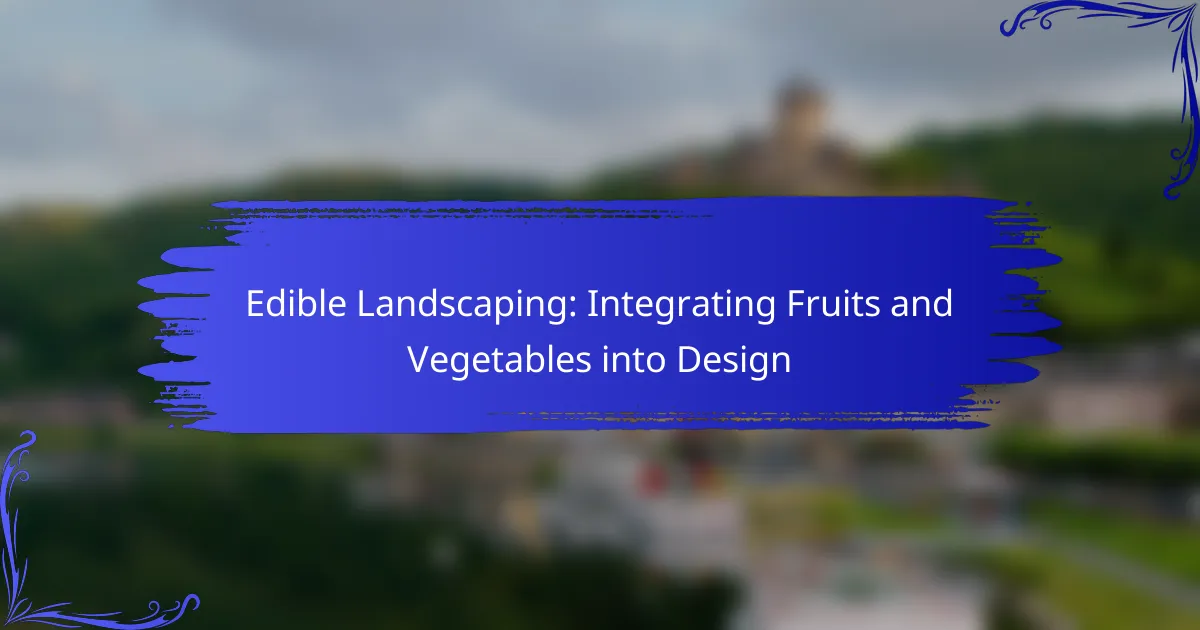Edible landscaping is the practice of integrating edible plants, such as fruits, vegetables, and herbs, into landscape design to enhance both aesthetic appeal and functionality. This approach promotes sustainability and biodiversity, reduces food costs, and encourages healthier eating habits. While there are benefits like improved food production and soil health, challenges include selecting appropriate plants, maintenance, pest management, space constraints, zoning restrictions, and public perception. The article explores the advantages of edible landscaping, its impact on local ecosystems, and the obstacles that homeowners may face when adopting this trend.

What is Edible Landscaping?
Edible landscaping is the practice of incorporating edible plants into landscape design. This approach enhances both aesthetics and functionality. It allows for the cultivation of fruits, vegetables, and herbs in gardens and yards. Edible landscaping promotes biodiversity and sustainability. It can reduce food costs and encourage healthier eating habits. Many homeowners are embracing this trend for its environmental benefits. Research shows that incorporating edible plants can improve local ecosystems. Edible landscaping transforms traditional gardens into productive spaces.
How does Edible Landscaping differ from traditional landscaping?
Edible landscaping focuses on incorporating food-producing plants into the landscape design, while traditional landscaping typically emphasizes ornamental plants. This approach allows for the integration of fruits, vegetables, and herbs alongside aesthetic plants. Edible landscaping promotes sustainability by providing fresh produce and reducing the need for store-bought food. In contrast, traditional landscaping often prioritizes visual appeal without functional food production. Studies show that edible landscapes can enhance biodiversity and improve soil health. Additionally, edible landscapes can contribute to community engagement and education about food sources.
What are the key principles of Edible Landscaping?
The key principles of edible landscaping include integration, diversity, sustainability, aesthetics, and functionality. Integration involves blending edible plants with ornamental plants in a cohesive design. Diversity refers to using a variety of plants to enhance resilience and productivity. Sustainability emphasizes practices that support ecological health and reduce resource consumption. Aesthetics focuses on creating visually appealing landscapes that incorporate edible elements seamlessly. Functionality ensures that the landscape serves practical purposes, such as providing food and habitat for wildlife. These principles guide the design and implementation of edible landscapes effectively.
How can Edible Landscaping enhance biodiversity?
Edible landscaping enhances biodiversity by incorporating a variety of plants that attract different species. This practice creates habitats for pollinators, such as bees and butterflies. Diverse plant selections support a wider range of insects and wildlife. Edible landscapes often include native plants, which are crucial for local ecosystems. These native species provide food and shelter for indigenous animals. Research shows that gardens with diverse plant life can increase species richness by up to 30%. Furthermore, edible landscaping promotes soil health and reduces erosion. This results in a more resilient ecosystem overall.
What types of plants are commonly used in Edible Landscaping?
Common plants used in edible landscaping include fruit trees, berry bushes, herbs, and vegetables. Fruit trees such as apple, pear, and cherry provide both beauty and harvest. Berry bushes like blueberries, raspberries, and strawberries offer vibrant colors and delicious fruits. Herbs such as basil, rosemary, and mint add flavor and aroma. Vegetables like tomatoes, peppers, and kale can be incorporated into decorative garden beds. These plants not only enhance aesthetics but also yield edible produce. Edible landscaping promotes biodiversity and sustainability in garden design.
Which fruits are best suited for Edible Landscaping?
Blueberries, strawberries, and raspberries are among the best fruits for edible landscaping. These fruits are not only delicious but also visually appealing. Blueberries offer attractive foliage and flowers, while strawberries produce vibrant red fruit. Raspberries provide a lush green backdrop with their tall canes. These fruits thrive in various climates and can be integrated into ornamental gardens. They also attract pollinators, enhancing the garden’s biodiversity. Additionally, they are easy to maintain and can be grown in containers or garden beds. Their dual purpose of aesthetics and edibility makes them ideal for landscape design.
What vegetables thrive in an Edible Landscape?
Vegetables that thrive in an edible landscape include tomatoes, peppers, and lettuce. These vegetables are well-suited for various climates and soil types. Tomatoes require full sun and well-drained soil. Peppers also need full sun and benefit from warm temperatures. Lettuce grows best in cooler weather and can be planted in partial shade. Additionally, herbs like basil and cilantro can complement these vegetables. They enhance flavor and attract beneficial insects. This combination creates a productive and visually appealing garden space.
How can Edible Landscaping be designed effectively?
Edible landscaping can be designed effectively by incorporating a variety of edible plants that thrive in the local climate. Selecting plants that are native or well-adapted to the region ensures better growth and sustainability. Grouping plants by their water and sunlight needs promotes efficient resource use. Incorporating vertical gardening techniques maximizes space and enhances visual appeal. Using companion planting can improve plant health and yield. Designing pathways and seating areas encourages interaction with the landscape. Additionally, incorporating seasonal planting schedules ensures year-round productivity. Research indicates that diverse plantings can enhance biodiversity and reduce pests, creating a healthier ecosystem.
What factors should be considered when planning an Edible Landscape?
When planning an Edible Landscape, several factors must be considered. First, the climate of the area influences which plants will thrive. Understanding the hardiness zone helps in selecting appropriate species. Second, soil quality is critical. Testing soil pH and nutrient levels ensures optimal growth conditions. Third, sunlight exposure affects plant health. Most edible plants require full sun for at least six hours daily. Fourth, water availability is essential. A reliable irrigation system supports plant needs, especially during dry periods. Fifth, space planning is important. Proper spacing between plants prevents overcrowding and promotes air circulation. Lastly, aesthetic considerations should not be overlooked. Integrating edible plants with ornamental features enhances visual appeal while providing food.
How can space be optimized for both aesthetics and productivity?
Space can be optimized for both aesthetics and productivity by integrating functional design with visual appeal. Utilizing vertical gardening techniques maximizes space while enhancing beauty. Selecting colorful, edible plants adds visual interest and encourages healthy eating. Implementing pathways and seating areas creates inviting spaces for relaxation and interaction. Incorporating native plants supports local ecosystems and reduces maintenance. Research indicates that well-designed green spaces improve mental well-being and productivity by up to 15%. Combining these elements fosters an environment that is both attractive and conducive to productivity.

What are the benefits of Edible Landscaping?
Edible landscaping provides numerous benefits, including enhanced food production and aesthetic appeal. It allows individuals to grow fruits and vegetables in their own yards, promoting self-sufficiency. This practice can reduce grocery costs by providing fresh produce at home. Additionally, edible landscapes can improve biodiversity by attracting pollinators and beneficial insects. They also promote environmental sustainability by reducing the carbon footprint associated with transporting food. Research indicates that gardens with edible plants can increase community engagement and social interaction. Furthermore, incorporating edible plants can improve soil health through organic practices.
How does Edible Landscaping contribute to sustainability?
Edible landscaping contributes to sustainability by promoting biodiversity and reducing resource consumption. It integrates food-producing plants into landscapes, which enhances local ecosystems. This practice encourages the cultivation of native species, which supports local wildlife. Edible landscaping reduces the need for transportation of food, lowering carbon emissions. It also minimizes water usage by incorporating drought-resistant plants. Studies show that urban edible gardens can reduce food waste and improve food security. Furthermore, these landscapes often use organic gardening methods, reducing chemical runoff into waterways. Overall, edible landscaping fosters a sustainable relationship between people and their environment.
What role does Edible Landscaping play in reducing food miles?
Edible landscaping plays a significant role in reducing food miles by enabling local food production. It allows homeowners and communities to grow fruits and vegetables in their own spaces. This practice minimizes the distance food travels from farm to table. Consequently, it reduces carbon emissions associated with transportation. Studies show that local food systems can cut food miles by up to 90%. By cultivating edible plants, communities can enhance food security and promote sustainability. Edible landscaping not only provides fresh produce but also fosters a connection between people and their food sources.
How can it promote local ecosystems?
Edible landscaping can promote local ecosystems by enhancing biodiversity. It introduces a variety of plants that attract beneficial insects and pollinators. This diversity supports local wildlife and improves soil health. Additionally, it reduces the need for chemical fertilizers and pesticides. By utilizing native plants, edible landscaping can restore natural habitats. It also encourages sustainable practices among community members. Studies show that increased plant diversity leads to healthier ecosystems. Overall, edible landscaping creates a balanced environment that supports various life forms.
What health benefits does Edible Landscaping provide?
Edible landscaping provides numerous health benefits, including increased access to fresh produce. This practice encourages the consumption of fruits and vegetables, which are vital for a balanced diet. Fresh produce is known to reduce the risk of chronic diseases such as heart disease and diabetes. Additionally, growing your own food can lead to increased physical activity, promoting overall fitness. Studies show that gardening can enhance mental well-being and reduce stress levels. Engaging with nature through edible landscaping fosters a connection to food sources, encouraging healthier eating habits. Furthermore, access to fresh food can improve nutritional quality, leading to better health outcomes.
How does growing your own food improve nutrition?
Growing your own food improves nutrition by providing fresh, organic produce directly from your garden. Homegrown fruits and vegetables are often harvested at peak ripeness, which enhances their nutrient content. Studies show that freshly picked produce retains more vitamins and minerals compared to store-bought options. For instance, a study published in the Journal of Agricultural and Food Chemistry found that homegrown tomatoes contain higher levels of antioxidants than those sold commercially. Additionally, growing your own food allows for control over the use of pesticides and fertilizers, leading to healthier food options. This practice also encourages a varied diet, as gardeners often experiment with different crops. Overall, cultivating your own food fosters better eating habits and nutritional awareness.
What psychological benefits are associated with gardening?
Gardening provides several psychological benefits. It reduces stress and anxiety levels. Engaging with nature promotes feelings of relaxation. Studies indicate that gardening can enhance mood and overall well-being. A 2016 study published in the Journal of Health Psychology found that participants felt more calm after gardening activities. Additionally, gardening fosters a sense of accomplishment and purpose. This is supported by research from the University of Essex, which highlights improved mental health in individuals who garden regularly. Social interaction through community gardening also contributes positively to mental health. Overall, gardening serves as a therapeutic activity with multiple psychological advantages.
How can Edible Landscaping save money?
Edible landscaping can save money by reducing grocery bills. Growing fruits and vegetables at home provides fresh produce without the cost of store purchases. It eliminates transportation costs associated with buying produce. Edible plants can also enhance property value, offering a return on investment. According to a study by the American Community Gardening Association, community gardens can lower food costs by up to 40%. Additionally, edible landscaping can decrease landscaping maintenance costs by incorporating productive plants. This dual-purpose approach maximizes land use and minimizes expenses.
What are the cost benefits of growing your own fruits and vegetables?
Growing your own fruits and vegetables significantly reduces grocery costs. Homegrown produce eliminates the need to purchase expensive organic options. The USDA reports that home gardening can save families an average of $600 annually. Additionally, growing your own food increases access to fresh produce, which may otherwise be costly. This practice also reduces transportation costs associated with buying from stores. Moreover, gardening can lower waste by allowing you to harvest only what you need. Overall, the cost benefits of growing your own fruits and vegetables are substantial and financially advantageous.
How does Edible Landscaping reduce grocery expenses?
Edible landscaping reduces grocery expenses by providing homegrown fruits and vegetables. Homeowners can cultivate a variety of produce in their gardens. This eliminates the need to purchase these items from grocery stores. Studies show that home gardens can reduce food costs by up to 50%. Growing your own food also ensures freshness and reduces waste. Additionally, edible landscaping can increase property value. The initial investment in seeds and plants is often recouped over time through savings on grocery bills.

What challenges are associated with Edible Landscaping?
Edible landscaping faces several challenges. One significant challenge is the selection of appropriate plants. Not all fruits and vegetables thrive in every climate or soil type. Maintenance is another hurdle. Edible plants often require more care than ornamental plants. Pest management can also be problematic. Edible plants attract pests, which may necessitate more frequent intervention. Space constraints are a common issue. Limited space can restrict the variety of plants that can be grown. Additionally, there may be zoning restrictions. Some areas have regulations that limit the types of plants allowed in landscaping. Finally, public perception can be a challenge. Some people may not understand the concept of edible landscaping, leading to resistance.
What common pests and diseases affect Edible Landscapes?
Common pests that affect edible landscapes include aphids, spider mites, and whiteflies. These pests feed on plant sap, weakening the plants and potentially spreading diseases. Diseases such as powdery mildew, downy mildew, and bacterial wilt are also prevalent. Powdery mildew appears as white, powdery spots on leaves, while downy mildew causes yellowing and wilting. Bacterial wilt leads to sudden plant collapse. Effective management includes regular monitoring and integrated pest management strategies.
How can these challenges be managed effectively?
Challenges in edible landscaping can be managed effectively through strategic planning and community involvement. First, selecting the right plants for the climate minimizes maintenance issues. Research indicates that native species often require less water and care. Second, implementing companion planting can enhance growth and reduce pests. Studies show that certain plant combinations can naturally deter harmful insects. Third, educating the community fosters engagement and shared responsibility. Programs that involve local workshops have proven successful in increasing participation. Finally, establishing a clear maintenance schedule ensures consistent care and productivity. Data from community gardens reveals that regular maintenance leads to higher yields.
What preventative measures can be taken to protect plants?
Preventative measures to protect plants include proper spacing, mulching, and regular monitoring. Proper spacing allows for adequate air circulation, reducing the risk of disease. Mulching helps retain moisture and suppress weeds. Regular monitoring enables early detection of pests and diseases. Implementing crop rotation can prevent soil-borne diseases. Using companion planting can deter pests naturally. Installing physical barriers, like row covers, protects plants from insects. Lastly, selecting disease-resistant plant varieties enhances overall resilience. These measures collectively contribute to healthier plants and improved yields.
What maintenance is required for an Edible Landscape?
Edible landscapes require regular maintenance to thrive. Key tasks include watering, weeding, and pruning. Watering should occur consistently, especially during dry spells. Weeding is essential to prevent competition for nutrients. Pruning helps promote healthy growth and fruit production. Fertilizing with organic matter enhances soil fertility. Pest management is crucial to protect plants from infestations. Regular monitoring for diseases ensures early intervention. Seasonal clean-up prepares the landscape for new growth.
How often should plants be watered and fertilized?
Plants should generally be watered once a week. This frequency can vary based on climate, plant type, and soil conditions. For example, during hot weather, plants may require more frequent watering. Conversely, in cooler months, less frequent watering is sufficient. Fertilization typically occurs every 4 to 6 weeks during the growing season. This ensures plants receive necessary nutrients for healthy growth. Over-fertilization can harm plants, so following recommended guidelines is essential.
What pruning techniques are beneficial for fruit and vegetable plants?
Pruning techniques beneficial for fruit and vegetable plants include thinning, topping, and training. Thinning involves removing excess branches or fruit to improve air circulation and light [censured]. This technique enhances fruit quality and reduces disease risk. Topping is cutting back the main stem to encourage bushier growth and more fruit production. Training involves guiding plant growth along trellises or supports to optimize space and sunlight exposure. These techniques lead to healthier plants and better yields. Research indicates that proper pruning can increase fruit size by up to 30% (Source: University of California Agriculture and Natural Resources).
What are some best practices for successful Edible Landscaping?
Successful edible landscaping involves strategic planning and plant selection. Choose plants that thrive in your local climate. Incorporate a mix of fruits, vegetables, and herbs for diversity. Use companion planting to enhance growth and deter pests. Design for aesthetics by considering plant heights and colors. Implement sustainable practices like composting and rainwater collection. Regular maintenance is crucial for health and productivity. Educate yourself on seasonal planting times for optimal yield.
How can companion planting enhance an Edible Landscape?
Companion planting can enhance an edible landscape by improving plant health and increasing yields. This technique involves growing different plants together for mutual benefits. For instance, certain plants can repel pests, while others attract beneficial insects. This natural pest control reduces the need for chemical pesticides. Additionally, companion plants can improve soil fertility by fixing nitrogen or enhancing nutrient uptake. Research has shown that specific combinations, like tomatoes and basil, can lead to better growth and flavor. Overall, companion planting promotes biodiversity, leading to a more resilient edible landscape.
What tips can ensure a fruitful harvest?
To ensure a fruitful harvest, select the right plants for your climate and soil. Research local varieties that thrive in your area. Prepare the soil by testing pH and nutrient levels. Amend the soil with organic matter to enhance fertility. Implement proper watering techniques, ensuring consistent moisture without overwatering. Use mulch to retain soil moisture and suppress weeds. Regularly monitor for pests and diseases, employing organic control methods when necessary. Prune plants appropriately to improve air circulation and fruit production. These practices can significantly increase yield and overall plant health.
Edible landscaping is the practice of incorporating edible plants, such as fruits, vegetables, and herbs, into landscape design, enhancing both aesthetics and functionality while promoting sustainability and biodiversity. This article explores the differences between edible and traditional landscaping, key principles, benefits, and challenges associated with edible landscapes. It also covers effective design strategies, common plants used, and maintenance practices necessary for successful implementation. Additionally, the article discusses how edible landscaping can reduce grocery expenses, improve nutrition, and contribute to local ecosystems.
